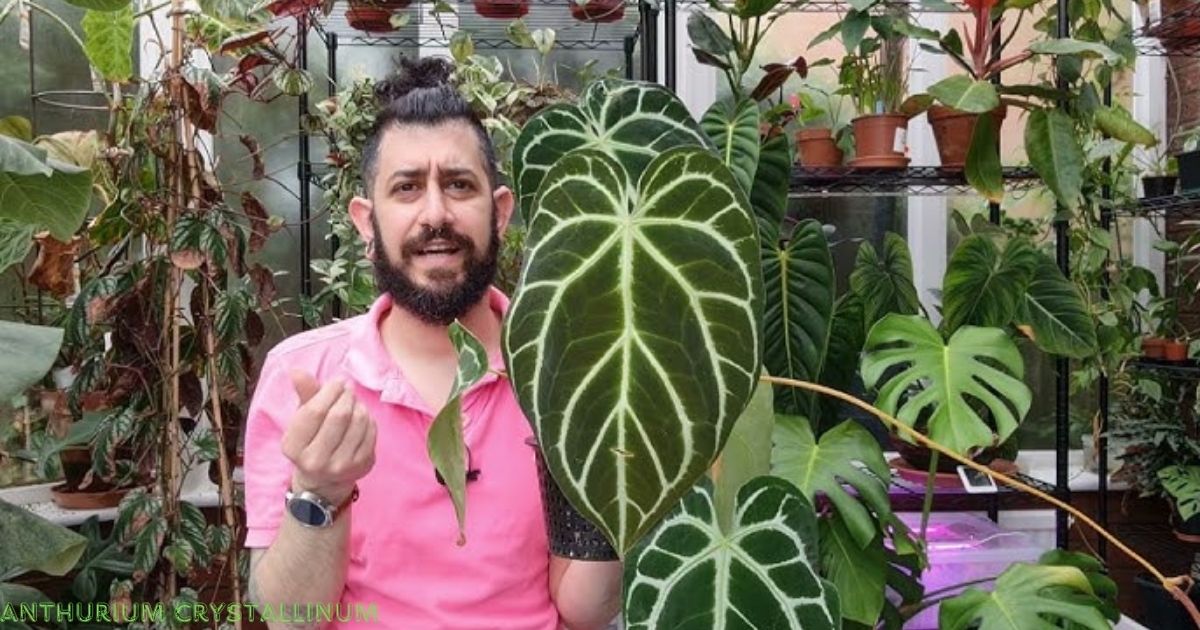Anthurium crystallinum is an evergreen perennial plant, widely loved for its large, velvety leaves with striking, crystal-like veins. While it can be challenging for beginners, once you understand its needs, this plant can be a rewarding centerpiece in any home.
Key Characteristics of Anthurium Crystallinum
This plant is recognized by its heart-shaped leaves with velvety textures and white, silvery veins. As the leaves mature, they can reach sizes of up to 12–24 inches long, and each leaf can last several months, creating a lasting display of tropical beauty.
Ideal Growing Conditions
Anthurium crystallinum requires warm, humid environments to thrive. It’s best suited for indoor environments with controlled humidity, though it can be grown outdoors in tropical regions. An ideal temperature range is between 65°F and 80°F, with nighttime temperatures no lower than 60°F.
Choosing the Right Potting Mix
The plant’s roots need aeration and excellent drainage, so a chunky, well-draining mix is best. A popular mix includes orchid bark, perlite, sphagnum moss, and a small amount of peat. This mimics the natural rainforest environment of Anthurium crystallinum and helps prevent root rot.
Planting and Repotting Anthurium Crystallinum
Repot your Anthurium crystallinum every 1–2 years or when you notice roots crowding the pot. Repotting is best done in the spring or early summer. Choose a slightly larger pot and refresh the potting mix to encourage healthy growth.
Watering and Humidity Requirements
Anthurium crystallinum needs consistently moist soil, but it’s crucial to avoid overwatering. Allow the top inch of soil to dry before watering again. Aim for a humidity level of 60–80%, which can be achieved with a humidifier, pebble tray, or by grouping it with other plants.
Light Requirements for Optimal Growth
Place your Anthurium in bright, indirect light. Too much direct sunlight can scorch the leaves, while too little light may slow growth and reduce the intensity of its leaf patterns. A north- or east-facing window is ideal, or use sheer curtains if near a south-facing window.
Fertilizing Tips
Feed Anthurium crystallinum with a balanced, water-soluble fertilizer diluted to half-strength once a month during the growing season (spring through early fall). Avoid over-fertilizing, as it can damage the roots and cause leaf burn.
Common Pests and Diseases
Anthurium crystallinum can be susceptible to pests such as spider mites, mealybugs, and aphids. Regularly inspect your plant and treat any infestations with insecticidal soap or neem oil. Root rot and fungal infections can occur if the soil remains too wet.
Pruning and Cleaning the Foliage
Occasionally remove any yellowed or damaged leaves to keep the plant looking healthy. Wipe the leaves gently with a damp cloth to remove dust, which can hinder photosynthesis and diminish the plant’s vibrant appearance.
Propagation Techniques
Anthurium crystallinum is typically propagated through division or stem cuttings. Carefully separate a section of the plant with its own root system, or take a stem cutting with at least one node, and plant it in moist sphagnum moss or water until roots form.
Common Issues and How to Fix Them
Yellowing Leaves: Usually caused by overwatering or inadequate drainage. Adjust your watering schedule and ensure the pot has proper drainage.
Browning Leaf Tips: Often due to low humidity or exposure to direct sunlight. Increase humidity and move the plant to a spot with indirect light.
Slow Growth: Could indicate insufficient light or nutrients. Try moving to a brighter location or consider a mild fertilizer.
Seasonal Care Considerations
During the colder months, reduce watering and fertilizing, as the plant’s growth rate slows. Consider adding a bit of extra humidity, as indoor heating can dry out the air, impacting tropical plants.
Fun Facts about Anthurium Crystallinum
Rare and Exotic: The plant’s stunning foliage and rarity in nature make it a coveted choice among plant collectors.
Symbiotic Roots: In the wild, Anthurium crystallinum grows as an epiphyte, often on trees, getting moisture and nutrients from the air.
Natural Air Purifier: Like many tropical plants, Anthurium crystallinum has natural air-purifying qualities, improving indoor air quality by absorbing toxins.
Conclusion
Anthurium crystallinum is a breathtaking plant with luxurious, velvety foliage that’s perfect for creating a tropical vibe in your home. While it requires specific care, particularly with humidity and light, the rewards are well worth the effort. With patience and proper attention, your Anthurium crystallinum will thrive and continue to impress for years to come.
FAQs
How often should I water my Anthurium crystallinum?
Water when the top inch of soil is dry, usually once a week, depending on humidity and temperature.
Can I grow Anthurium crystallinum outdoors?
Yes, in tropical regions with temperatures above 60°F. Otherwise, it’s best suited as an indoor plant.
What type of pot is best for Anthurium crystallinum?
Choose a well-draining pot, such as terracotta or plastic with drainage holes, to prevent waterlogging.
How do I increase humidity for my Anthurium crystallinum?
Use a humidifier, place it on a pebble tray with water, or group it with other plants to create a humid microclimate.
Why are my Anthurium crystallinum leaves turning yellow?
Yellowing is often due to overwatering or poor drainage. Check your watering habits and potting mix to ensure proper moisture levels.
